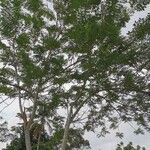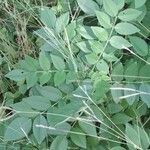An evergreen shrub or tree. It grows to 10 m high and spreads to 3 m across. The crown is irregular. The bark is grey. The stem is erect and branching. The young branches are hairy. The leaves are compound with 8 to 14 leaflets. These are 7 cm long and 3 cm wide. They come to a blunt tip at the top end and are rounded at the base. The flowers are pink and yellow in the centre with a green stripe. They are pea shaped. The flowers occur in 10 cm long clusters. They are produced on older twigs. The fruit is a woody pod 15 cm long and up to 2 cm wide. The seeds are purplish brown and round. They are 1 cm long and 9 mm wide.
stamens diadelphous, the tube ca. 12 mm long, 3 mm wide at the base, free filaments alternately long and short; ovary linear, ca. 1 cm long, 1 mm wide, glabrous, the stipe to 5 mm long, the style to ca. 4 mm long, the stigma capitate. Fruit light to dark brown, narrow, oblong, ca. 15 cm long, 2 cm wide, the stipe to 1 cm above the persistent cup shaped calyx, margined, surface dull, glabrous, faintly wrinkled or striate; the valves hard, twisting in dehiscence; seeds 3-10, dark brown, nearly round to somewhat oblong, compressed, to 1 cm long.









